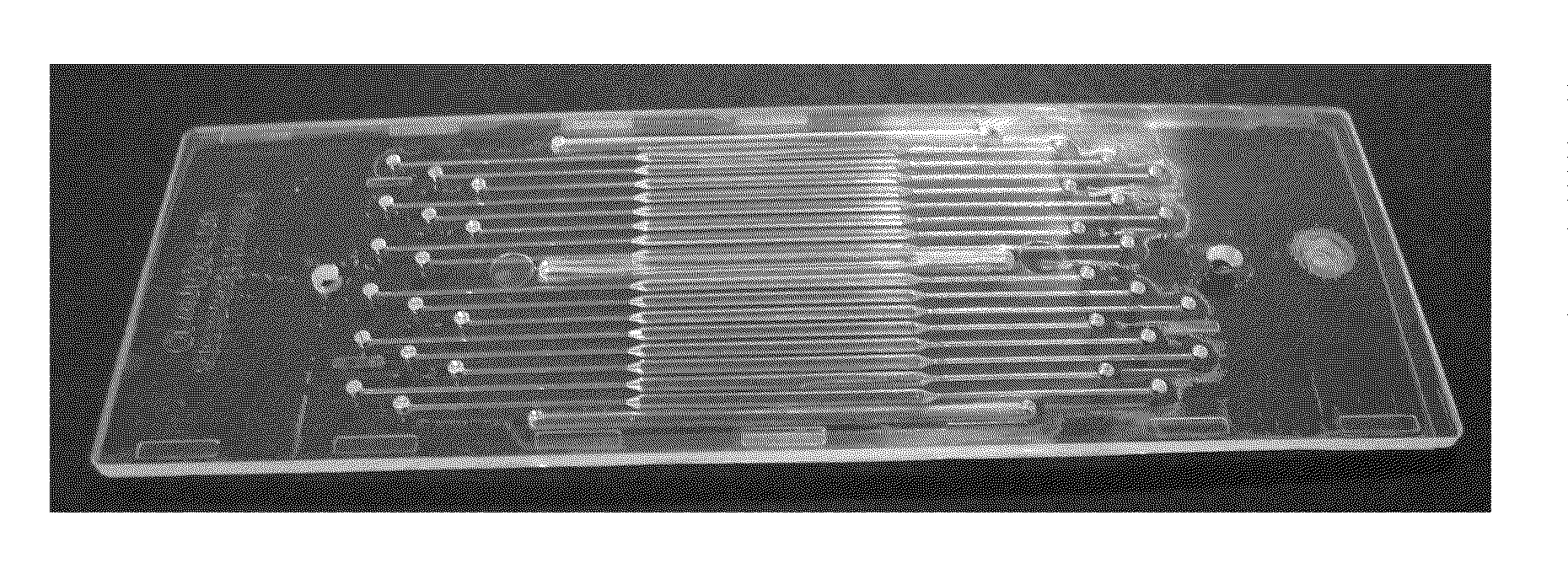Methods for rapid multiplexed amplification of target nucleic acids
a target nucleic acid and multiplexing technology, applied in the field of rapid multiplexing amplification of target nucleic acids, can solve the problems of difficult to find an area of medicine not impacted by pcr, difficult to find a medical field, and limited commercially available thermal cycling instruments, etc., to achieve rapid heat and cool reaction solutions, reduce the effect of ramping and settling times
- Summary
- Abstract
- Description
- Claims
- Application Information
AI Technical Summary
Benefits of technology
Problems solved by technology
Method used
Image
Examples
example 1
Custom Thermal Cycler and Microfluidic Biochip
[0113]A thermal cycler of the invention, as shown in FIG. 1A, was used to perform fast cycling by allowing the PCR reaction solution temperatures to be heated and cooled rapidly, controllably, and reproducibly. This instrument accepts a 16-chamber microfluidic biochip and consists of a high output thermoelectric cooler / heater mounted to a high efficiency heat sink. Each of 16 PCR reaction solutions was placed into an individual chamber of the microfluidic biochip, coupled to the heat pump by applying a 0.2 MPa of compressive pressure with a clamping mechanism. FIG. 1B shows a photograph of the 16-sample disposable plastic microfluidic biochip. Each PCR chamber is 500 μm deep and approximately 1 mm wide and holds 7 μl of PCR reaction solution.
[0114]Instrumentation and Temperature profiles
[0115]In the following examples, all amplification reactions in tubes were performed with an Eppendorf Mastercyler™ ep gradient S (Eppendorf North Americ...
example 2
Temperature Profiles of Thermal Cycling Instruments and Reaction Solutions in Conventional PCR Tubes and Microfluidic Biochips
[0136]Amplification reactions were performed in thin-walled PCR tubes using a commercial thermal cycler and in microfluidic biochips using the thermal cycler of Example 1. For tube reactions, the Eppendorf Mastercyler™ was utilized. FIG. 2A shows the temperature of the block and the reaction solution within a tube for one of the 28 thermal cycles using a conventional STR cycling protocol. The Mastercycler™ heating and cooling system is based on a heat pump with an integrated block for tube insertion. The time and temperature setpoints are 1 minute at 98° C. for denaturation, 1 minute at 59° C. for annealing, and 1 minute at 72° C. for extension. A comparison of the temperature profiles for the heat block and the reaction solution shows a lag in the response of the solution temperature relative to the block temperature. The measured heating and cooling rates o...
example 3
Evaluation of PCR Enzymes in Tubes
[0140]A large number of polymerases were evaluated for potential use for fast, multiplexed STR analysis, and candidates were selected based in part on hot-start activation time and extension rate. The reported properties of the four polymerases selected for experimental evaluation compared with recommended conditions for TaqGold™ are presented in Table 1 (A).
TABLE 1AReported Polymerase characteristicsPolymeraseATGSpeedSTARPyroStartKOD3′-5′ Exonuclease activityNoYes, NoYesGeneration of 3′-dA overhangsYesYes, >80%YesNoHot Start mechanismChemical modifiedAntibodyChemical modifiedAntibodyInitial activation95° C. / 11 min95° C. / 1 min95° C. / 1 min95° C. / 2 minElongation rate [nucleotides / sec]16.67100-20040100
TABLE 1BOptimized performance of polymerases in tube reactionsStandard ATGOptimized ATGSpeedSTARCycling conditions95° C. / 11 min95° C. / 11 min95° C. / 1 min94° C. / 1 min98° C. / 10 sec98° C. / 4 sec59° C. / 1 min {close oversize bracket} ×2859° C. / 45 sec {close over...
PUM
| Property | Measurement | Unit |
|---|---|---|
| Temperature | aaaaa | aaaaa |
| Temperature | aaaaa | aaaaa |
| Temperature | aaaaa | aaaaa |
Abstract
Description
Claims
Application Information
 Login to View More
Login to View More - R&D
- Intellectual Property
- Life Sciences
- Materials
- Tech Scout
- Unparalleled Data Quality
- Higher Quality Content
- 60% Fewer Hallucinations
Browse by: Latest US Patents, China's latest patents, Technical Efficacy Thesaurus, Application Domain, Technology Topic, Popular Technical Reports.
© 2025 PatSnap. All rights reserved.Legal|Privacy policy|Modern Slavery Act Transparency Statement|Sitemap|About US| Contact US: help@patsnap.com



